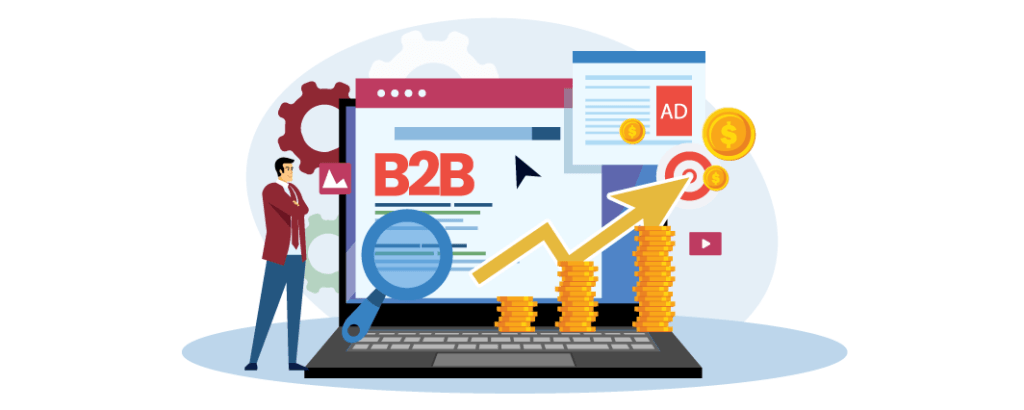
Sales leaders in B2B companies know how challenging it is to generate high-quality leads while adhering to tight budgets. That’s why many companies are looking for paid search strategies and tools to produce targeted leads for the sales team.
In our guide, we will equip you with the most important elements of an effective B2B paid search strategy. By utilizing some proven techniques, you can enhance your campaigns and achieve measurable results. Let’s unlock the full potential of your online advertising efforts.
Why B2B Paid Search Strategies Matter
Before we dive into the specifics, it’s crucial to understand what goes into a successful B2B paid search campaign. A well-executed strategy helps you:
- Reach specific audiences actively searching for your products or services
- Increase click-through rates (CTR) and conversion rates
- Maximize ROAS
- Track and optimize ad performance
Let’s explore how to build an effective paid search strategy that aligns with these goals.
Key Components of a Successful Paid Search Strategy
Building a successful paid search strategy in B2B marketing requires a comprehensive understanding of some key components to achieve results. Each element plays a distinct role in ensuring that your campaigns are visible, compelling, engaging, and can drive conversions.
Implementing the following paid search strategies can help you set a solid foundation for reaching your marketing objectives and enhancing the return on your ad spend.
1. Identify Relevant Search Terms and Keywords
The foundation of any paid search strategy, such as Pay Per Click (PPC) advertising, is keyword research. Before running any PPC ads, you will want to identify specific keywords that your target audience is likely to use. Tools like Google Ads Keyword Planner and Semrush can help you find high-performing search terms in your industry.
Additionally, consider long-tail keywords (phrases with three or more words), as they tend to have higher conversion rates and lower competition in search results.
2. Segment Your Ad Groups
Organize your keywords into tightly-knit ad groups to create highly relevant ads. This segmentation ensures that your ads appear for the most relevant searches, improving CTR and conversion rates. For B2B companies, consider segmenting based on:
- Industry
- Product or service type
- Buyer persona
- Pain points
This effort allows for more relevant ad copy and landing pages, resulting in higher CTRs and conversion rates. For example, if you provide manufacturing products and services for small businesses, create separate ad groups for keywords related to each product or service you offer.
Another valuable tool is using negative keywords to prevent your ads from showing up for irrelevant searches. Adding negative keywords can improve the quality of your traffic and tighten up your ad spend by ensuring you’re not wasting ad dollars targeting the wrong customers.
3. Craft Compelling Ad Copy
Your ad copy should be clear, concise, and compelling. You will want to highlight the unique value propositions of your products or services and include strong calls to action (CTAs). Make sure your ad copy addresses the pain points of your B2B buyers and offers solutions.
It’s important to review and update your ad copy regularly to keep it fresh and relevant. Additionally, utilizing A/B testing can significantly enhance your ad copy’s effectiveness by allowing you to compare different versions and identify which resonates most with your audience.
Taking the time to constantly review performance metrics — such as CTR and conversion rates — will inform adjustments and optimizations. Using this data will help your messaging remain impactful and aligned with your audience’s needs.
4. Optimize Landing Pages
A seamless user experience is essential for converting clicks into leads. Ensure that your landing pages are optimized for both desktop and mobile users. Key elements of high-converting landing pages include:
- Relevant and engaging content
- Easy-to-complete forms
- Clear CTAs
- Easy navigation
- Fast loading times
Additionally, if you have access to social proof, such as testimonials or case studies, you can build even more credibility with potential clients. Regularly reviewing and updating these pages based on performance metrics will help you maintain their effectiveness in driving conversions.
5. Utilize Google Analytics and Data Tracking
To optimize your ad accounts effectively, leverage tools like Google Analytics for data tracking. You can monitor key metrics such as click-through rates, conversion rates, and ROAS.
Then, you can use this data to make informed adjustments to your campaigns. Additionally, consider using conversion tracking to track leads and sales generated by your ads. Then, you will have a better idea of whether your ad campaigns are having the desired impact on sales opportunities.
6. A/B Test Your Ads
Continuous improvement is crucial in digital marketing. Perform A/B tests on different ad copies, landing pages, and CTAs to determine what resonates best with your audience. This process will help you refine your strategy and improve overall performance.
When you regularly analyze your ad campaigns’ performance, you can identify areas for improvement. Then, use the collected data to refine your strategy. This approach will help you optimize your ROAS and stay ahead of competitors.
7. Leverage Social Media for Retargeting
Social media platforms offer excellent opportunities for retargeting campaigns in B2B marketing. You can use display ads on platforms such as LinkedIn to re-engage prospects who have previously interacted with your search ads. This proven approach can significantly boost your lead generation efforts.
When implementing retargeting campaigns on social media, it’s essential to tailor your messaging to reflect the specific interests and behaviors of your audience. By focusing on personalized content and utilizing data-driven insights, you can enhance user engagement and drive higher conversion rates from your retargeted ads.
Find Support Implementing a B2B Paid Search Strategy
A well-crafted B2B paid search strategy can dramatically improve the efficiency and effectiveness of your marketing efforts. Focusing on the right keywords, segmenting your ad groups, optimizing landing pages, and implementing the other strategies we highlighted can enhance your ROAS and drive more qualified leads.
The challenge for many B2B companies is having the time, resources, and technology available to put these strategies into action. That’s why you will want to partner with a digital marketing agency that specializes in B2B paid search.
At Marketing Refresh, you can use our expertise to optimize your campaigns and achieve remarkable results. Our award-winning team understands how to turn paid search campaigns into new business opportunities for your company.
Talk to us today about how to supercharge paid search and start generating more qualified leads for your sales team.
FAQs
- What is B2B paid search marketing?
B2B paid search marketing involves using paid advertising strategies to attract business clients through search engines. It typically incorporates keyword targeting, ad segmentation, and data analysis to generate leads and increase sales opportunities.
- How do I choose the right keywords for my B2B paid search campaigns?
Selecting the right keywords involves researching terms that potential clients use to search for your products or services. Focus on long-tail keywords, consider your target audience, and analyze competitors to identify keywords that will yield higher conversion rates and lower competition.
- How often should I update my ad copy?
Regular updates to your ad copy are recommended to keep it relevant and engaging. Consider reviewing and refreshing your ads every few weeks or whenever you notice significant changes in performance metrics, such as click-through rates (CTR) or conversion rates.
- What tools can help me track the performance of my B2B paid search campaigns?
Google Analytics is a powerful tool for tracking key metrics such as CTR, conversion rates, and Return on Ad Spend (ROAS). Additionally, various ad platforms provide their own analytics and reporting features to help you gauge the success of your campaigns.
- Why is retargeting important in B2B marketing?
Retargeting is essential in B2B marketing as it allows you to reconnect with potential clients who have previously shown interest in your offerings. By serving tailored ads based on their prior interactions, you can enhance engagement and increase the likelihood of conversions, ultimately improving your overall marketing effectiveness.


